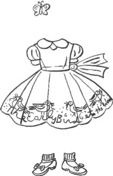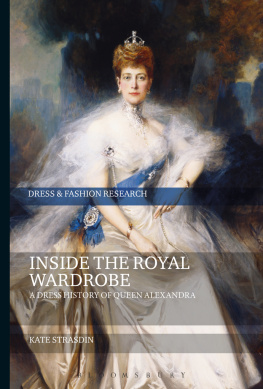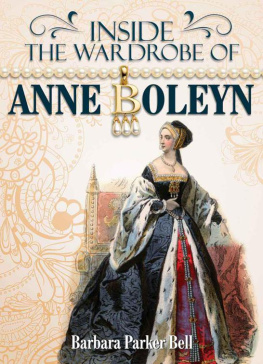ALSO BY ELIZABETH KENDALL
American Daughter
The Runaway Bride:
Hollywood Romantic Comedies of the 1930s
Where She Danced:
The Birth of American Art-Dance
COPYRIGHT 2008 BY ELIZABETH KENDALL
ALL RIGHTS RESERVED. PUBLISHED IN THE UNITED STATES BY PANTHEON
BOOKS, A DIVISION OF RANDOM HOUSE, INC., NEW YORK, AND IN CANADA BY
RANDOM HOUSE OF CANADA LIMITED, TORONTO.
PANTHEON BOOKS AND COLOPHON ARE REGISTERED TRADEMARKS
OF RANDOM HOUSE, INC.
THE FOLLOWING PATTERNS APPEAR ON THE COVER JACKET AND ARE
REPRODUCED BY KIND PERMISSION OF THE MARIMEKKO CORPORATION .
COPYRIGHT MARIMEKKO CORPORATION. ALL RIGHTS RESERVED .
JOONAS/DESIGNED BY MAIJA ISOLA 1961 MARIMEKKO
UNIKKO/DESIGNED BY MAIJA ISOLA 1964 MARIMEKKO
LEHTIMAJA/DESIGNED BY MAIJA ISOLA 1958 MARIMEKKO
HEVOSKASTANJA/DESIGNED BY NORA FLEMING 2004 MARIMEKKO
LIBRARY OF CONGRESS CATALOGING-IN-PUBLICATION DATA
KENDALL, ELIZABETH, [DATE]
AUTOBIOGRAPHY OF A WARDROBE / ELIZABETH KENDALL.
P. CM.
eISBN: 978-0-307-37751-7
1. KENDALL, ELIZABETH, 1947- 2. AUTHORS, AMERICAN20TH CENTURY
BIOGRAPHY. I. TITLE .
PS 3611.E5337Z46 2008
813.6 DC 22 2007033613
WWW.PANTHEONBOOKS.COM
v3.1
The Wardrobe dedicates this book to:
JOAN KREVLIN ,
Reader, Critic, Supporter
and
ALEXANDRA KENDALL ,
all of the above
and
Muse
Contents
The remaining dresses, though they had lost their freshness, still kept the long unerring lines, the sweep and amplitude of the great artists stroke, and as she spread them out on the bed the scenes in which they had been worn rose vividly before her. An association lurked in every fold; each fall of lace and gleam of embroidery was like a letter in the record of her past.
EDITH WHARTON , The House of Mirth
Do people have time to feel pain when they are shot? What on earth will Alyosha and Vasya say when they have to fill in forms about their parents? What a shame about that new silk dress that fitted me so well and that I never had a chance to wear.
EUGENIA GINZBURG , Journey into the Whirlwind
Will the frock I wept in
Answer me to wear?
EMILY DICKINSON , Before the ice is in the pools
INTRODUCTION
B . sat on the floor in a dark classroom with the other grad students. It was Sensitivity Training. The teacher told them to close their eyes and imagine in their hands, a book. The book was their own autobiography and they should start to read it.
B. gripped the book tightly, took a breath, opened her eyes, and began to readabout something she had no idea she remembered. It was herself, when small, climbing out of the lower bunk in the early morning, crossing the room to a white dresser, opening a bottom drawer to find a pile of small red corduroy overalls that smelled clean. She took one off the top of the pile.

There was I, present in her deepest of memories. I am B.s wardrobe, her ever-evolving second skin. She is My inhabitant, My partner, My BodyMy B.

From way back in time, those overalls were telling the grown B. who she had been; who she still was. They were hers alone. I was hers aloneand have remained so, through upheaval, sturm und drang. I am her language, of body and style. I am soundless and mute, but extremely expressive.

What B. must remember (what she sometimes forgets) is how much wisdom and common sense is stored in Me, from My ancient past.
If bodies and wardrobes can keep such things in mind, can listen to each otherI dont mean fuse together, but not abandon each other eitherwhat can result is a habit of communication that has surprise in it. Such communication does not breed inertia, but the opposite. Its like a marriage thats alive. Or like a friendship that grows over years, until the friends have gotten to an instantaneous understanding of each others thoughts.
B. and Iafter much pain and sorrowwe are finally friends.
This is My story of that friendship.
SASH/HOW I WAS BORN

F ive-year-old B. in a daffodil-yellow pinafore and a white blouse with puffed sleeves stands at the end of a chintz couch, in the midst of grandparents, aunts, and parents. The pinafore has embroidery on the skirt and a wide yellow sash tied at the back of the waist. B. is leaning into the mother, who is sitting on the couch holding a baby brother. On B.s feet are red party shoes with ankle straps and white socks. At her right temple, a white barrette holds back straight, fine dishwater-blond hair.
This dress can stand as well as any for My birth. Wardrobes start out like children, without conscious identity. I was the emanation of the family at the Country Club on a spring day, in a large midwestern city, just after midcentury. Technically, I suppose Id been born earlier, in a downtown cathedral, as a long, white, lace-trimmed christening gown (overly long, because thats how the Middle Ages phrased its wish for babies to live and grow). Or else in the preverbal moment when the very small B. took out the red corduroy overalls.
But that day at the Club was when I first knew Myself, when I suddenly heard what B. was saying to Me: You smell clean. You are the color of lemon pie. You have a story on your skirt.
Adults had bent down to read the embroidery on the skirt, then patted B.s head. What theyd seen were red-thread birds and brown-thread squiggles among green-thread sprinkles, and underneath, the sewn red words The early bird gets the worm.
Only Americans had put words on clothesthen. At that moment (it was the 1950s), words on clothes were a new idea. In this case they were a message from the business community that had bought the dress.
The rest of Me that day matched the style of the little girls clothes in books read to B. at home: Peter Pan, The Little Princess, the ubiquitous Alices Adventures in Wonderland. B. was sashed, buttoned, and hair-brushed into an immaculate Edwardian wrapping, missing only Alices horizontally striped stockings.
How did I, a wardrobe, know I was antique at birth? Thats what I do. I pick up intimations of sartorial history.
Other family members in that tableau were not thinking history, but merely checking off the right thing on each other: cinch belts on the young aunts; tweed suits on the older ladies; red bow ties on the older men; spectator pumps on the young mother. And for a small female like B., it was de rigueur to wear a crisp sashed cotton dress and these exact red shoes with a thin strap around the ankle and a red grosgrain bow (like a bow tie) on the toe. This dress code had come from the young mother. Astonished, like so many postwar brides, at having been promoted from ingenue to matron, she couldnt yet imagine a new era. She dressed B. as if she were not her child, but a version of herself as a child, before the war.




















